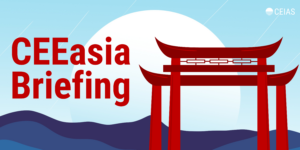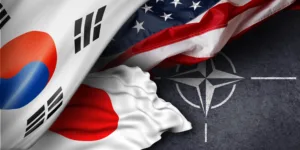For the past week, Taiwan has been gripped by protests ignited by the controversial bills pushed through by the pan-Blue majority in the Legislative Yuan. These demonstrations, which began before President Lai Ching-te’s inauguration, have been named the “Bluebird Movement” and compared to the Sunflower Movement, Taiwan’s major case of civil disobedience from a decade ago.
Within the current legislature sworn in after the January 2024 elections, the pan-Blue camp is composed of the Kuomintang (KMT) and the Taiwan People’s Party (TPP). Its counterpart, the pan-Green camp, is currently composed only of the Democratic Progressive Party (DPP), the party of President Lai. As the January elections saw the DPP lose its legislative majority and the support of other pan-Green parties that failed to win their seats, the pan-Blue legislators wasted no time after parliament reconvened using their majority to push through several controversial bill amendments.
With the legislature having already passed some of the less controversial amendments, most of the current controversy concerns amendments to the Law Governing the Legislative Yuan’s Power that would expand the investigative powers of parliament, allowing it to summon both public and private entities for questioning under investigatory committees. Should the summoned individuals or agencies withhold, delay in providing or otherwise provide false information, they could be subjected to hefty fines or criminal charges under what has been vaguely termed as “contempt of the legislature.” This is another proposed amendment, but to the Criminal Code, which is yet to be voted on.
Such powers would go way beyond the legislature’s current functions in overseeing (and, indeed, questioning) the executive, which is concerning for reasons beyond undermining the DPP-held executive. There are concerns that the amendments could not just be weaponized against different individuals and agencies that hold sensitive information (e.g., concerning national security matters), but undermine the broader democratic principles of checks and balances in Taiwan by blurring the lines between the functions of the Legislative and Control Yuan. The latter is the main supervisory and investigatory body in Taiwan responsible for impeachment, censure and audit of government officials.
Moreover, the KMT and the TPP have tried to pass the investigative rights bill without revealing it in full or allowing for a line-by-line review of its amended provisions before its second reading. This prompted further concerns about transparency and procedural justice, reminiscent of the 2014 attempts by the KMT (then in power) to pass the Cross-Strait Services Trade Agreement (CSSTA) without proper deliberation and ratification by parliament, which sparked the Sunflower Movement. Thus, it is worth comparing the current protests—as well as the actions by the pan-Blue camp—with the events of 2014, in order to see whether such comparisons are, indeed, valid.
Democracy and Taiwan’s History of Civic Activism
Undeniably, there are similarities between the current protests and the Sunflower Movement, especially in relation to the actors involved and their underlying values. Both protests attracted people from all walks of life, with several of the prominent NGOs and civil society groups from the Sunflower Movement being involved in the current demonstrations. Both protests were also spurred by the actions of the KMT that were deemed unconstitutional by the public. And, while the protests this year were prompted by the actions of the legislators rather than the actions of officials from the Executive Yuan as in 2014, the underlying goal that united the demonstrators in both cases was the protection of Taiwan’s democratic values.
Such a focus on democracy also makes the current protests reminiscent of other demonstrations, including the 1990 Wild Lily Movement or the 2008 Wild Strawberry Movement. Indeed, Taiwan has a long history of pro-democratic civic activism. Moreover, the parallels between this year’s events and the Sunflower Movement have been made by the protesters themselves (not just the observers), who have chanted several of the movement’s slogans and sung the movement’s anthem.
The scale of the current protests is noteworthy. The demonstrations on May 24 have seen more than 100,000 people gather in the streets of Taipei, which is by far not the only city where the protests took place. There are, however, doubts about whether the demonstrations can develop into a full-scale occupation of the legislature, as happened during the Sunflower Movement. One of the reasons for these doubts relates to the fact that structural factors that had enabled the Sunflower Movement’s month-long occupation of the Legislative Yuan without a major crackdown by the police forces, such as the relatively even balance of power between the KMT’s “mainlander and “Taiwanese” factions, are no longer present. Indeed, as pointed out by Brian Hioe, Han Kuo-yu, the current Speaker of the Legislative Yuan who belongs to the “mainlander” faction, is arguably more likely to call upon the police to disperse the demonstrators than was Wang Jin-pyng, the speaker at the time of the Sunflower Movement, who belonged to the KMT’s “Taiwanese” faction.
The “Third Force”, the “Blue Terror” and the Sunflower Legacy
The broader context has also changed. Soon after the Sunflower protests, several activists successfully entered electoral politics to create a so-called “Third Force” as an alternative to the KMT-DPP divide. However, such a “Third Force” no longer exists. The New Power Party (NPP) failed to retain its legislative seats in the January elections and the TPP has turned into a pan-Blue party. Moreover, Huang Kuo-chang, the former NPP heavyweight and one of the most prominent leaders of the Sunflower Movement, has defected to the TPP.
On the one hand, the lack of a “Third Force” makes the current situation more comparable to the pre-Sunflower years. On the other hand, the increasing populist tendencies of the pan-Blue camp, which facilitated the election of Han Kuo-yu as the legislative speaker, may complicate the protesters’ ability not just to stage a full-scale occupation but also to prevent the proposed amendments from passing into law.
The risk of such complications is likely to increase with the KMT’s seeming determination to reciprocate what it called the DPP’s “Green Terror” with its own “Blue Terror.” Indeed, its other legislative proposals, including its proposal to revive the Special Investigation Division—which was, prior to its dissolution, used for politically-motivated arrests under the auspices of the Ministry of Justice—and to place it under parliamentary control, imply just that.
Moreover, the memory of the Sunflower Movement itself is increasingly contested, as seen in both Ko Wen-je’s and Huang Kuo-chang’s references to the movement’s legacy when criticizing the DPP’s failure to pass a cross-strait oversight bill, which they claim was the movement’s fundamental objective. Ko has also emphasized the movement’s goal of safeguarding procedural justice to prevent future cases of “black boxing”, as seen in case of the CSSTA consultations. This makes his calls for reviving the CSSTA during his presidential campaign even more striking.
The legacy of the Sunflower Movement was also evoked during the protests organized by the TPP in support of the proposed legislative changes. These protests, which occurred a day before Lai’s inauguration, saw TPP supporters holding guavas—the Mandarin (as well as Taiwanese) word for which (芭樂 or rather 芭樂票) can also mean “bad check”—as a reference to the DPP’s unfulfilled promises, alleged corruption and failure to tackle the increasing array of domestic issues.
Won’t Back Down: Taiwan’s Lesson for Democracies
Several amendments to the Law Governing the Legislative Yuan’s Power have already passed, and it remains to be seen whether any further amendments will pass, including the proposed Criminal Code revisions. It also remains to be seen whether the allegations of the bills’ unconstitutional nature will prompt the Judicial Yuan to step in.
Regardless of the outcome of the current protests, however, the determination of the Taiwanese activists to take matters into their own hands and engage in peaceful protests when elected officials threaten to undermine the country’s democratic principles is clear. Moreover, because post-Sunflower Taiwan has strengthened its democratic governance and shown the world the possibility of economic diversification away from China, the current protests may produce further lessons. This is made even more pertinent by the international community’s focus on the KMT’s and TPP’s unconstitutional practices that can tarnish Taiwan’s international image. If nothing else, the importance of civil disobedience in protecting democratic values is a lesson on its own.







